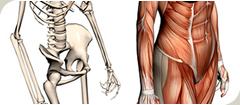Introduction
Arthritis encompasses both osteoarthritis and inflammatory arthritis. These processes can involve both the hip joint, and affect persons across the spectrum of all societies and all ages.
The word arthritis is derived from the Greek ‘arthron’ meaning joint, and ‘itis’ meaning inflammation. It therefore simply means inflammation of a joint.
Arthritis is not a new disease - it has been identified in the skeletal remains of our Neolithic ancestors and it affects virtually all mammals.
Osteoarthritis
Osteoarthritis is poorly understood and it embraces a diverse group of conditions.
Primary osteoarthritis occurs in genetically susceptible middle–aged or elderly people who often have a family history of arthritis. Frequently, several joints are involved. The condition is not relentlessly progressive.
Secondary osteoarthritis occurs when the cartilage, the underlying bone or the geometry of the joint is damaged. The increased stress tends to be localised to one particular area and usually only a part of the cartilage is worn away.
In the younger age group, osteoarthritis may develop secondary to a congenital dislocation of the hip joint, or an abnormally shaped hip joint, which is known as dysplasia of the hip (acetabular dysplasia). Osteoarthritis may also result from specific entities such as Perthes (Legg-Calves-Perthes) disease, or a slip of the growth plate during one’s early teens (Slipped Upper Femoral Epiphysis).
Rheumatoid (Inflammatory) Arthritis
Rheumatoid arthritis is the archetype of inflammatory arthritis. Patients can be detected by screening for genetic markers. It usually forms part of a more general illness and ultimately many joints may be involved.
Patients with inflammatory arthritis are often stiff for prolonged periods in the mornings. This stiffness gradually wears off with activity during the course of the day. The hands and wrists are usually involved first but any joint in the body may become affected. The inflammatory nature of the disease, which can be monitored by blood tests, results in a gradual erosion of all the cartilage of the joint. In addition the lining (synovium of the joint) is usually inflamed and enlarged and superficial joints (e.g. wrists, elbows, not the hip) present with a boggy swelling.
There are numerous types of inflammatory arthritis. Many of these are called reactive because they are secondary to some other underlying condition, for example diseases of the skin (psoriasis) or bowel (ulcerative colitis) or venereal disease. Inflammatory arthritis may also occur in children and is known as juvenile chronic arthritis.
It is important to recognise that there are many different types of arthritis, the causes of which are largely unknown.
Treating Arthritis with Surgery
The average age of patients undergoing hip replacements is 66 years old. Among all age groups 60% of total hip replacements are performed on women.

The symptoms of arthritis of the hip include pain in the groin, which sometimes radiates down the front of the thigh. This is often likened to a burning feeling and may be associated with a sensation of grating on movement of the hip. Sometimes the grating is audible. With time there is loss of function which is evidenced by increasing difficulty with putting on socks, getting in and out of cars etcetera. Typically the hip is a bit stiff and painful in the morning but this may wear off with activity, only to get worse towards the evening.
Total hip replacement has alleviated the pain and improved the mobility of hundreds of thousands of patients crippled with arthritis of the hip.

